Tablecloth on the table for the kitchen: requirements and varieties

Every housewife wants the kitchen to be not only functional, but also cozy. Textiles will help create such an atmosphere: using it on the windows and on the dining table will give the interior a touch of home warmth.
In the age of modern technology and industrial development, materials for tablecloths are variable, however, this does not affect their aesthetic appeal: they are still beautiful and appropriate accessories for the kitchen. Let's look at what the requirements for such products are, what they are made of, and also dwell on the recommendations for their choice.


Requirements
Despite the fact that, to a greater extent, a tablecloth for a dining table is its decoration, it must obey a number of requirements. For example, a product must be made made of safe materialbecause it will come into contact with food. It is important to choose an option that meets safety standards. Previously, there were parameters regulated by GOST, the products also had technical documentation.
Today, due to the variety of materials from which products are made, the requirements for each variety are different. For example, for textile options, the edges must be finished: it is unacceptable that they go unkempt with each wash. Other modifications must comply with the whiteness standards, and not less than 80%. At the same time, the percentage of threads used in spinning is important for them.


The general requirements are the type of fabric and the conformity of the artistic and aesthetic quality indicators to the reference samples.
Matters and main background... In this case, the drawing can be both large and small. Besides, size is important... If earlier they were obliged to obey GOST, today this trend is outdated, since the sizes of the tables for which the tablecloths are purchased have departed from the usual standard values.


However, the rule is not completely ruled out: the tablecloth should not hang down to the floor, because this will make household members confused in it. Is important and practicality: the product should be easy to clean, not wrinkled, deformed or slipping. The tablecloth should be the basis of the table, its decoration, utensils should be stably placed on it.
In addition, the tablecloth should be of some kind protective materialprotecting the surface of the countertop from rapid wear. The key requirements for the material are resistance to various kinds of dirt, ease of maintenance, durability.


On the aesthetic side, the product should fit into the overall concept of the kitchen style... And here the material will be a decisive factor, because in one case you cannot do without textiles with its support in the form of curtains, and in the other you will need to use a synthetic version, which will perfectly demonstrate the belonging of the tablecloth to a specific interior style.
Some options are used precisely as protective covers for expensive countertops. They also comply with the general requirements established by the regulation.


Variety of options
The tablecloth for the kitchen can be different, but conditionally it can be classified by purpose. She happens everyday and festive... Products of the first type are made from practical materials.
The main difference between such models is the size of the edge overhang: it does not exceed 20 cm on each side of the tabletop. A tablecloth that can be used to cover a dining table on a holiday can have an overhang ranging from 20 to 40 cm.


Products of the second type can be very diverse, which is expressed in the use of various materials and patterns... For example, a print can be thematic (New Year's, spring, wedding) or standard-typical (with an openwork edge, floral motifs).
Concerning overhang, then for home use it should be small, for a restaurant table, on the contrary, it must cover most of the distance from the table top to the floor.


Elegant tablecloths can be made from expensive materials. Depending on the design idea, they can be decorated with different decor. For example, it can be cross stitch or satin stitch embroidery. Such products are rarely used, their load is more aesthetic than functional.


An interesting nuance is the fact that modern design may need additional accessories for the tablecloth.
These can be ready-made sets with tracks or so-called runners, which are placed across the table, placing dishes, vases on them, or using the tracks as panthers.
Use of small submates allows you to add a special flavor to the design. Moreover, in any style: tablecloth bed covers can be made of contrasting textiles, rattan, plastic, cork or bamboo.
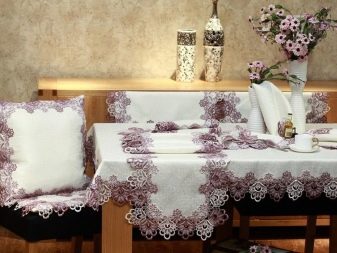

Materials (edit)
Raw materials for making tablecloths on the kitchen table can be very diverse.
Natural textiles
In the classic version, they are made made of cotton and linen. Textile varieties are breathable and environmentally friendly. However, they let water and any liquid that gets on them (including fat, which is problematic to remove). Therefore, they are not able to protect the surface of the countertop material from it.
In addition, textiles require frequent washings. Such tablecloths are used mainly to decorate kitchens in the styles of country and Provence, where it is impossible without them.

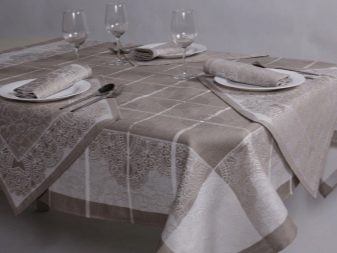
Blended fabrics
In order to improve the quality and practical properties of modern brands add synthetic threads to natural fiber... This makes washing easier by eliminating grease and oil particles between the fibers. Mixed textiles are also good because they wrinkle less. However, these tablecloths have a significant drawback: they cannot be boiled or bleached.
They are afraid of heat and need a delicate wash.


Impregnated
Often, special impregnations are used in the production of tablecloths. based on acrylic or Teflon... Natural textiles are treated with this solution in order to increase its strength characteristics. The big advantages of such products are their durability, resistance to stains and tears.
In addition, these tablecloths do not pass or absorb water, and also repel dirt. However, this variety has its drawback: the range of such tablecloths is small.


Oilcloth
Oilcloth is one of the best solutions when choosing a tablecloth for the kitchen. Unlike fabric options, it does not allow water or grease to pass through, thereby preserving the material of the countertop. Such material is classified as budgetarybecause it is short-lived: despite the different film thicknesses, it afraid of cuts... In addition, often during operation, its top coating is erased along with the pattern, becoming faded and worn out.
These tablecloths cannot be machine washed or ironed. In addition, they can deform when in contact with something that is too hot.
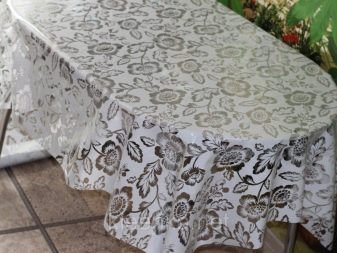

Vinyl
These tablecloths perform based on non-woven fabric... They are soft and consist of two layers (a synthetic film and a soft backing). Their advantage is the widest range of colors, in addition, their front side is often decorated with various patterns.
These tablecloths perfectly protect the tabletop material from water and grease. Caring for such a material is simple: it is enough to wipe it with a damp cloth in a timely manner.
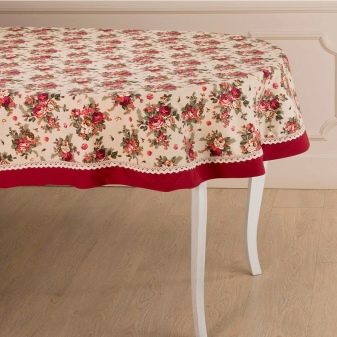

Silicone
In a modern kitchen interior, a silicone tablecloth looks better. It is often called glass or "soft glass" because it really is looks like a glass sheet... In fact, this is a dense PVC film, the thickness of which is several millimeters. Depending on the design, it can be transparent or filled with a variety of colored fillers.
In most cases, a silicone tablecloth has no overhangs and is cut strictly along the contour of the table top. It is dense and quite stiff, does not drape and does not form a fold.


Shapes and sizes
Today, tablecloths can be round, rectangular, square or oval. Round options are considered classics. They fit perfectly into the interior of the kitchen, both classic and modern, depending on the type of material used. Oval varieties are purchased for rectangular or oval tables: otherwise they have different overhangs at the edges, which does not always look beautiful.
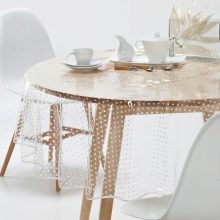


Square the products are good for small kitchen tables. They look very aesthetically pleasing, they can become a decoration of the dining area. Today they are often purchased for round tables.
Rectangular tablecloths are timeless classics, these are options for every day and holidays. Moreover, depending on the design, they can be either single or double.


As for the sizes, they can be different. It depends on the dimensions of the dining table available in the kitchen:
- for a square table with dimensions of 90x90 cm and four seats, it is worth buying a tablecloth measuring 140x140 cm;
- for a rectangular table measuring 90x60 cm, you will need a 110x140 cm tablecloth;
- if the table is larger and is 120 cm long, the best solution for its design would be a tablecloth with parameters 160x140 cm;
- for a large table for 6 seats with a tabletop length of 150 cm, you can choose a product with dimensions of 160x140 or 200x140 cm;
- on a table 280 cm long, designed for 12 people, you can lay a tablecloth with parameters 240x140, 260x140, 280x140, 300x140, 320x140 cm;
- for a small round table with a diameter of up to 110 cm, you need to choose a tablecloth with a diameter of 1.5 meters;
- if the diameter of the kitchen table is 150 cm, it is more advisable to buy a product with a diameter of 2 m.



As for the tablecloths made of dense PVC film, their sizes are selected individually according to the size of the countertops. Such products are sold by the meter, cutting off the length required by the buyer from the roll.

Design
The design of the tablecloth for the kitchen table can be different. In addition to the fact that it can be decorated with overlays, tracks and pad covers, the appearance of the product itself can be remarkable. For example, craftswomen can sew tablecloths using a variety of technologies. Some of the most interesting options are products made in technology patchwork.
Today it is very diverse, due to which each tablecloth turns out to be exclusive. The fragments from which the tablecloth is assembled can have different shapes, combining with each other in a certain color scheme. A geometric pattern is laid out of them, covering the inner side with a thin lining base.
Such products are able to decorate the kitchen on the days of special celebrations, or they are custom-made specifically for the specific style of the kitchen space.


Fabric varieties, decorated with knitted decor... Of course, they cannot be called practical either, but they look especially beautiful on the festive table.
As a rule, such decor is sewn on top of a through stitching.Sew-on knitted elements located along the overhangs give the product a special flavor, due to which it fits well into such styles as, for example, provence or country.


Silicone tablecloths look very harmonious in the kitchen interior with a transparent background and a simple pattern. Due to the imitation of the glass base, they bring a considerable amount of lightness into the interior composition, which is usually lacking in the kitchen. At the same time, the subject of the drawing can be very diverse, including floral and plant motives. They look most beautiful in white and silver.


Some people like the so-called gas tablecloths or very thin textile options. Often they are embroidered gold or silver embroideryand also decorate with the finest lace braid... These products are very beautiful, but they are completely impractical. In addition, such textiles can be damaged if they accidentally touch the tablecloth.
Interesting options from textiles, decorated with lace braid or built-up folds. As a rule, their main part remains empty, which is very good for decorating tablecloths with paths or even napkins. The originality of the product is acquired due to the braid itself: it can be wide, narrow, plug-in, stitched over the main material.
Someone likes the design of the tablecloth with ruffles, which also looks very nice, even if they are made of material identical to the main canvas without any decoration.

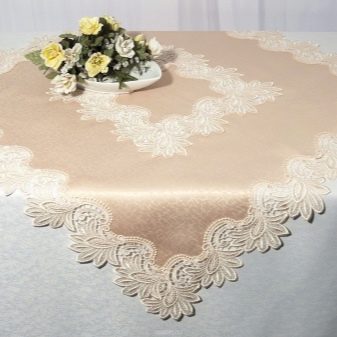
Selection recommendations
The kitchen table accessories market is rich in proposals that can satisfy the tastes of a wide range of buyers. The offered assortment is so huge that it is easy to get confused in it.
However, no matter how bright the eyes are, the purchase must be deliberate, because otherwise it will be useless.. Whatever item you like, be it a water-repellent transparent model, an oilcloth variety or a thermal cloth, you need to weigh the pros and cons.


You need to imagine whether this product will fit the existing kitchen interior. In this case, it is important to take into account the size of the room itself. For example, if the kitchen is spacious and the table is large, you can purchase a product with ruffles and napkins, or an option with a large print located along the border.
In a small kitchenette with a lack of footage, a tablecloth with large overhangs and complex decor will be inappropriate. There is enough models without drawing, because unnecessary print elements will overload the available space.


The first thing to note for yourself is appointment... If the product is taken for everyday use, it is advisable to look closely at the options from synthetic materials.
The fabric, whatever one may say, will constantly cling (for example, with a large overhang for the legs of the sitting person, as well as with an accidental mechanical jerk). Such tablecloths are needed, but for everyday use they should be indestructible and short, because any touching and pulling of textiles can cause existing dishes to fall off the table.

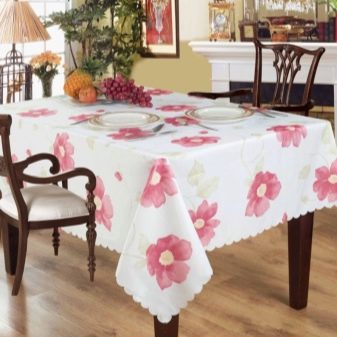
The product, no matter what material it is made of, must obey the specific style of the kitchen.
In this case, it is necessary to take into account the general design concept... For example, a tablecloth with a cheerful colorful pattern will look ridiculous in an interior of, say, a classic design. Here you need an expensive tablecloth, always embroidered with gold, with prints and monograms.

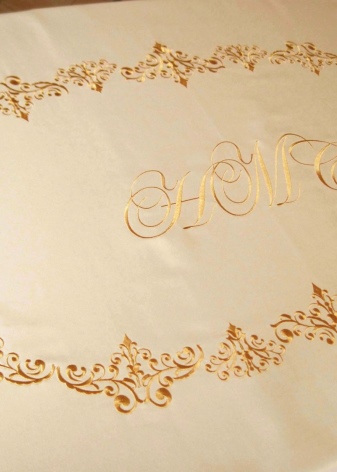
If you plan to purchase a product for laconic directions (for example, minimalism or conservatism), it is worth buying an ordinary silicone film without any pattern, because it will be superfluous. For stylistics countryon the contrary, the abundance of drawings and prints is important. Therefore, the best solution for decorating the dining table would be the patchwork version of the tablecloth. For modern a variety with a deliberately shiny artificial texture of the material is needed. At the same time, it is important that, for all its simplicity, the tablecloth seems elegant.


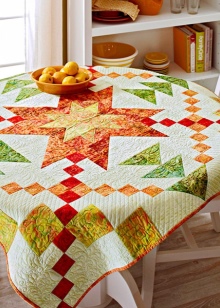
According to the rules of color design of the interior, it should not contain more than four contrasting shades. Looking closely at this or that tablecloth in the store, it is worth considering that its the color should not stand out against the background of existing furniture and household appliances. If in doubt, you can pay attention to the color of the backsplash. Made in a related shade, it will be his support, thereby creating the illusion of the unity of the color scheme.
Sometimes the color of the tablecloth is selected taking into account the shade of the kitchen curtains. Also, some craftswomen buy one material, making curtains and a tablecloth from it. It cannot be said with all certainty that this solution is a good one, since the abundance of the same textiles in a small room, such as the kitchen, makes the space boring and monotonous. You need to choose a color that does not exactly copy one of the four tones in the interior, it is preferable that it be related.
This will add versatility to the design without detracting from its aesthetic perception. In this case, preference should be given to light shades of the color palette: they are aesthetically pleasing, and they do not create a feeling of overloading the interior.

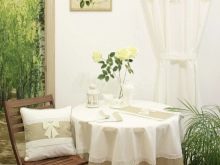
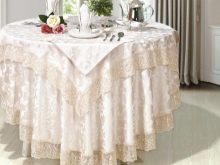
Few people like it when, in order to more or less comfortably sit at the table, you have to raise the long overhangs of the tablecloth. This is not only inconvenient, but also contributes to the pulling of the material, and with it - everything that is currently located on the table. Floor-length tablecloths are not the best choice for the kitchen: they are inconvenient in everyday life and make it difficult to clean the floor.
Perfectly the overhang should not reach the knees of the seated person... So that in the future you do not have to adjust the parameters of the product by sewing it in or cutting off the lace oilcloth border, look at the dimensions of your kitchen table. Add 20-25 cm to its sides - this is quite enough to make the product look beautiful and comfortable for everyday use. Alternatively, you can buy or sew a product with an elastic band around the edges, which will prevent the material from pulling off the table.


If we compare all the known varieties of the accessory, then the most successful of them will be silicone tablecloth large thickness. It does not slip on the surface of the table top, does not form a fold, due to which even small objects will stand securely on such a table. Considering that such a product has no overhangs, it will not cling to the legs of household members when sitting down at the table.


The practicality of oilcloth products and analogues with water-repellent impregnation depends on the type of material, its thickness and the substrate used. Sometimes even the seller cannot understand what the difference is, although with a close look everything is simple: the substrate for non-woven and fabric is different. Here you need to take a closer look: textiles have a perpendicular weave of threads, while non-woven fabric does not.
A good option for the budget category is a tablecloth impregnated with a textile base.

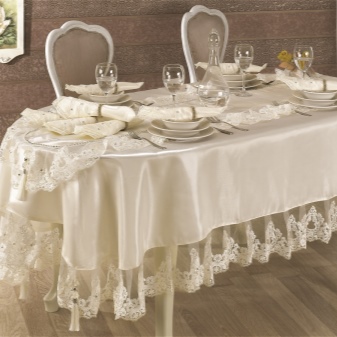
Whichever product you want to buy, each line has its own favorites, distinguished by quality and durability. That is why the range of prices is so great. For example, oilcloth with the smallest thickness, which is cheaper than analogues in its segment, will tear faster in the kitchen than denser models. And if the texture of the material is rough, such oilcloth will quickly break off against the edges of the table (expensive oilcloth is dense, but not dry).
As for the prices for textile tablecloths, as a rule, options made from natural fibers are more expensive. However, not everything is so simple: linen is natural, but it wrinkles a lot, cotton is good, but you also need to choose a fabric with such threads correctly, because the looser it is, the faster the tablecloth will wear out. Synthetics, which are located in the mid-price category, do not always withstand hotter. Cheap fabrics quickly wrinkle, besides, they are distinguished by a loose weave of threads, due to which they shrink when washing more than other analogues of their line.


How to choose a tablecloth for the kitchen table, see the video below.













The comment was sent successfully.